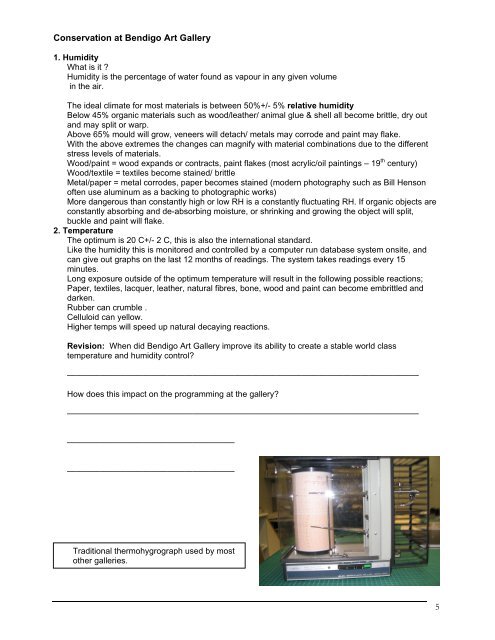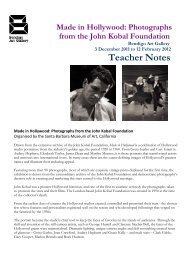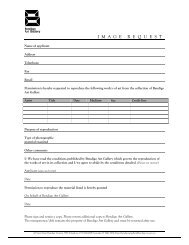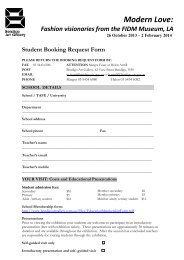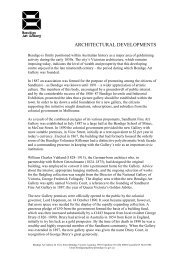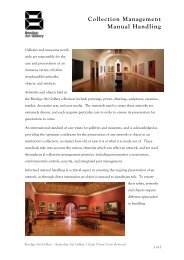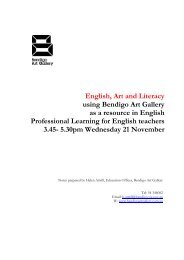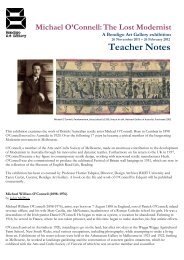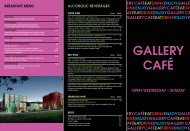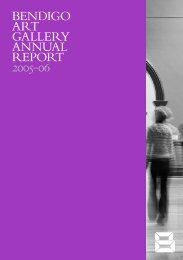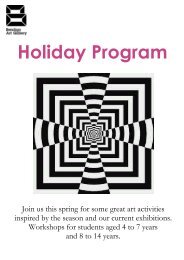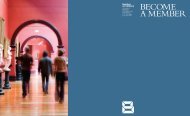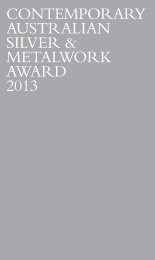Studio Arts Exam Revision booklet - Bendigo Art Gallery
Studio Arts Exam Revision booklet - Bendigo Art Gallery
Studio Arts Exam Revision booklet - Bendigo Art Gallery
Create successful ePaper yourself
Turn your PDF publications into a flip-book with our unique Google optimized e-Paper software.
Conservation at <strong>Bendigo</strong> <strong>Art</strong> <strong>Gallery</strong><br />
1. Humidity<br />
What is it ?<br />
Humidity is the percentage of water found as vapour in any given volume<br />
in the air.<br />
The ideal climate for most materials is between 50%+/- 5% relative humidity<br />
Below 45% organic materials such as wood/leather/ animal glue & shell all become brittle, dry out<br />
and may split or warp.<br />
Above 65% mould will grow, veneers will detach/ metals may corrode and paint may flake.<br />
With the above extremes the changes can magnify with material combinations due to the different<br />
stress levels of materials.<br />
Wood/paint = wood expands or contracts, paint flakes (most acrylic/oil paintings – 19 th century)<br />
Wood/textile = textiles become stained/ brittle<br />
Metal/paper = metal corrodes, paper becomes stained (modern photography such as Bill Henson<br />
often use aluminum as a backing to photographic works)<br />
More dangerous than constantly high or low RH is a constantly fluctuating RH. If organic objects are<br />
constantly absorbing and de-absorbing moisture, or shrinking and growing the object will split,<br />
buckle and paint will flake.<br />
2. Temperature<br />
The optimum is 20 C+/- 2 C, this is also the international standard.<br />
Like the humidity this is monitored and controlled by a computer run database system onsite, and<br />
can give out graphs on the last 12 months of readings. The system takes readings every 15<br />
minutes.<br />
Long exposure outside of the optimum temperature will result in the following possible reactions;<br />
Paper, textiles, lacquer, leather, natural fibres, bone, wood and paint can become embrittled and<br />
darken.<br />
Rubber can crumble .<br />
Celluloid can yellow.<br />
Higher temps will speed up natural decaying reactions.<br />
<strong>Revision</strong>: When did <strong>Bendigo</strong> <strong>Art</strong> <strong>Gallery</strong> improve its ability to create a stable world class<br />
temperature and humidity control?<br />
——————————————————————————————————————————<br />
How does this impact on the programming at the gallery?<br />
——————————————————————————————————————————<br />
————————————————————<br />
————————————————————<br />
Traditional thermohygrograph used by most<br />
other galleries.<br />
Air conditioning system<br />
5


